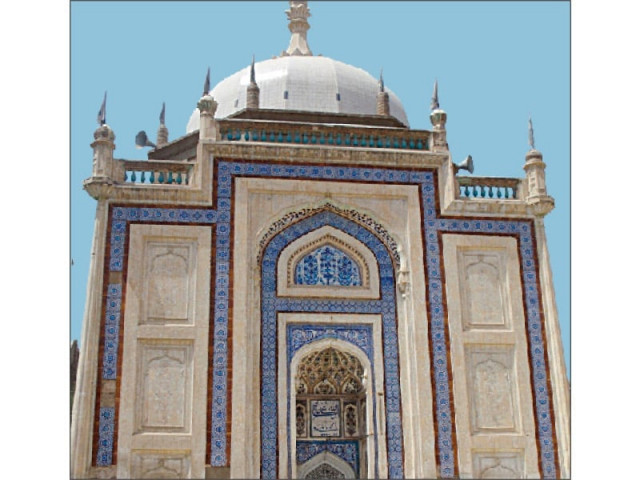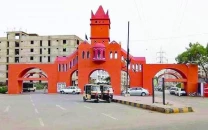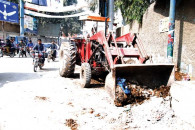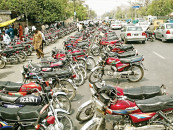Becoming history: The plunder of Shikarpur by its very own sons
Host city of Sindh’s first rental power plant has slowly fallen off the map.

Becoming history: The plunder of Shikarpur by its very own sons
Today’s Shikarpur is famous for its Kulfi Falooda at Deewan Thakurdas’s in Lakhidar, its Haji Maula Bux Memon’s mango in vinegar pickle and paapar. But centuries ago, it was better known for its schools and as a hub for trade in gold, spices, cotton – all part of merchant traffic to Central Asian states.
“My Shikarpur was not like the one you see today,” muses Israr Ahmed Alvi, who is a retired professor of Sindhi and resident of the ancient city. Back in the day, Hopeful Academy high school attracted students from far-flung areas. Indeed, the academy, now known as Government Boys High School, was affiliated with Bombay University and therefore passing class 10 was known to be an uphill task.
Shikarpur was also the first city to have an intermediate college. This was a time when the Hindu traders of Shikarpur invested in the city. According to Sindhi Professor Anwar Figar Hakro of Sindh University at Jamshoro, these men took whatever they earned while doing business with Central Asian states and put it into the city. Two traders Sital Das and Chella Sing donated Rs100,000 and Rs50,000, respectively for C&S College which was built from 1927 to 1932. And as Sindh was a part of Bombay province the governor of Bombay inaugurated the college.
“Today we are talking about independent power plants or rental power plants,” said Prof. Alvi. “But Shikarpur was the first in Pakistan to get an independent power plant more than a century ago. It belonged to a Hindu trader and used to provide the city an uninterrupted supply.”
As with cities that became centres for culture and trade, Shikarpur was strategically located. Prof. Anila Naeem of NED University says it was established in 1617 AD by the Daudpotas, who developed it as a hub for banking and political clout during the 18th and 19th centuries. Towards the mid-18th C, it was under complete Afghan control (Kandahar state), which encouraged Hindu merchants to settle here and carry on trade through Afghanistan to Central Asia and India.
As the city was easily accessible through the Bolan Pass, brass and metal goods, carpets, cotton cloth, and embroidery flowed through it via the Dhak or covered bazar. Its traders had links with merchants in Iran, Iraq, Samarkand, Sumatra. Business was so brisk that the Central Bank of India opened a branch here.
Welfare projects were abound such as a hospital constructed by a Hindu philanthropist Rai Bahadur Udhavdas Tarachand where all treatment, medicines, food and even fruit and milk were provided free of charge.
Today Shikarpur looks very different but it was originally a planned city with seven doors and a window, which were closed after 8 pm. These doors are Lakhidar, Hathidar, Cividar, Wagnodar, Karandar, Khanpuridar and Hazaridar, while name of window was Siddiq Marri.
Professor Hakro has prepared a map of the city from 80 years ago when he estimates its population was not more than 50,000. The experts are unanimously of the view that it was after 1947 that decline set it, partly from the influx of people from the rural areas. Today its population has swelled to one million.
The human burden has shown on Shikarpur’s heritage. Many cultural sites were damaged during the Movement for Restoration of Democracy in the ‘80s, while others bore the brunt, more recently, during violence after the assassination of Benazir Bhutto in December 2007.
Additionally, after Partition, migrants from India were allotted precious houses through claims. And when all of them left for Karachi within a couple of years they stripped the city of its famed teak doors and windows of carved wood. Today you can find them in fancy restaurants in Karachi’s DHA and in homes of the rich and famous.
The Sindh culture department has issued a list of 1,203 places, which have been declared cultural heritage. This has come too late, he said, but adding that much needs to be done to preserve what is left. For example, the doors, windows and roofs which were made of teak, which is weather and termite resistant two centuries ago, are still in a good shape and can be taken care of. A skeptical Naeem notes that while 100 most endangered sites have been declared world monuments in 2008 and 2010, little has been done to officially protect them aside from paperwork. The vandalism continues.
Aside from historical buildings, other infrastructure has met the same fate. For example, the city, which was famous for it underground drainage system had hydrants which were used to wash the streets twice daily. Today only a few remain in Dhak bazaar. Prof. Naeem laments that none of the authorities have bothered to stop people from demolishing historic structures or constructing edifices that don’t keep in with the environment.
And thus Shikarpur, which was home to great dynasties of the Soomros, Shaikhs, Bhayos, Mahars, Pathans or Jatois, has not been protected by its very own sons.
Published in The Express Tribune, May 2nd, 2012.



















COMMENTS
Comments are moderated and generally will be posted if they are on-topic and not abusive.
For more information, please see our Comments FAQ